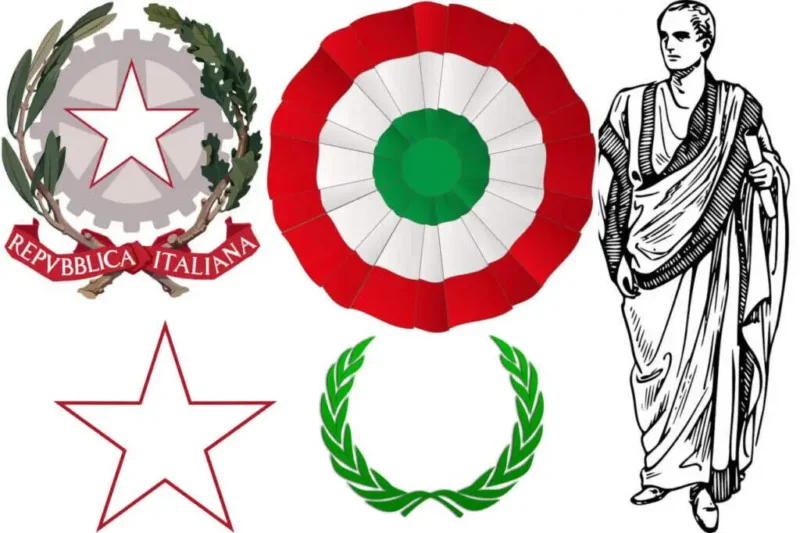From the ancient ruins of Rome to the rolling hills of Tuscany, Italy is a country full of vibrant culture and captivating history. One way that Italian culture has been preserved for centuries is through its unique symbols – each with its own powerful meaning. In this article, we will uncover the origins and significance behind some of Italy’s most famous symbols. We will explore how these symbols have come to represent different aspects of Italian life, from religion to politics and everything in between.
Along the way, we’ll discover why these symbols still remain relevant today – allowing us to gain insight into an important part of Italian culture that has stood the test of time. Some of Italy’s most well-known symbols include the Colosseum, the Leaning Tower of Pisa, and the Italian flag with its green, white, and red stripes. Other significant Italian symbols include the olive branch, the fleur-de-lis, and the cross, each with its own unique history and meaning. By understanding these symbols, we can gain a deeper appreciation for the rich history and culture of Italy.
Investigating the Significance of La Dolce Vita
 La Dolce Vita is one of Italys most iconic symbols and has come to represent a certain lifestyle. It symbolizes the Italian culture, art, and film industry as well as its capacity for pleasure-seeking and hedonism. Through exploring this famous symbol, we uncover deeper meanings about the nation’s people, values and beliefs. The phrase was first introduced in Federico Fellini’s film La Dolce Vita released in 1960 which follows a journalist who moves through Rome over seven days encountering different characters along the way. Its success spawned numerous copies but none have been able to capture the same charm that Fellini’s original did.
La Dolce Vita is one of Italys most iconic symbols and has come to represent a certain lifestyle. It symbolizes the Italian culture, art, and film industry as well as its capacity for pleasure-seeking and hedonism. Through exploring this famous symbol, we uncover deeper meanings about the nation’s people, values and beliefs. The phrase was first introduced in Federico Fellini’s film La Dolce Vita released in 1960 which follows a journalist who moves through Rome over seven days encountering different characters along the way. Its success spawned numerous copies but none have been able to capture the same charm that Fellini’s original did.
The movie offered a glimpse into high society life with an emphasis on decadence, pleasure seeking and excess – all characteristics associated with la dolce vita today. In addition to being featured prominently in films such as La Dolce Vita and Roman Holiday (1953), it has become synonymous with fashion trends like tailored suits for men or slim fitting dresses for women; cultural activities such as opera or theatre performances; fine dining experiences focused on regional cuisine; recreation opportunities including beach visits or skiing trips; leisurely pursuits like reading books or taking strolls around town squares; music styles like jazz or classical compositions; literature genres centred on love stories between rich protagonists living luxurious lifestyles (think Romeo & Juliet); art gallery exhibits featuring classic paintings by renowned painters such as Botticelli, Michelangelo or Caravaggio – just to name a few! Ultimately the term encompasses any aspect of Italian life that offers joyous moments of relaxation and escape from everyday realities.
It is clear that La Dolce Vita encapsulates much more than just physical pleasures – it represents freedom from constraints combined with appreciation for beauty found in everything around us: food, nature, love affairs… In short it stands for living life fully knowing how precious each moment can be no matter how small or mundane it may seem at first glance!
Deciphering the Symbolism Behind Italys National Anthem
 When it comes to the national anthem of Italy, there is much more than what meets the eye. Behind its famous lyrics and stirring melody lies a wealth of symbolism that can be uncovered with careful examination. For example, some believe that the lyrics “Fratelli d’Italia” (Brothers of Italy) were inspired by Napoleon Bonaparte’s call for Italian unification in 179Additionally, phrases such as “la speranza della libertà” (the hope of freedom) are thought to represent Italians desire for independence from foreign powers.
When it comes to the national anthem of Italy, there is much more than what meets the eye. Behind its famous lyrics and stirring melody lies a wealth of symbolism that can be uncovered with careful examination. For example, some believe that the lyrics “Fratelli d’Italia” (Brothers of Italy) were inspired by Napoleon Bonaparte’s call for Italian unification in 179Additionally, phrases such as “la speranza della libertà” (the hope of freedom) are thought to represent Italians desire for independence from foreign powers.
The iconic lion featured on the flag also holds particular significance; it has been used since ancient times as an emblem for strength and courage among Italys population. Furthermore, some contend that certain verses within the anthem point towards a strong relationship between God and country – something which many view as integral to Italian culture today. All these factors combine to create an incredibly powerful symbol for all citizens of Italy – one whose true meanings may only be fully understood when we take time to decipher its deeper symbolism.
Unveiling the Representation of Italia Turrita
Italia Turrita is one of Italys most recognizable symbols, representing the country and its people for centuries. With a crown on her head, an armor breastplate depicting the Italian flag across her chest, and a sheathed sword in hand, Italia Turrita stands tall as an icon of strength and unity.
This powerful representation has evolved over time to include new meanings that reflect modern Italy. In this article we will explore the various interpretations of Italia Turrita throughout history, from its origins as a symbol of Roman conquest to today’s meaning as guardian angel for all Italians. By understanding these changing representations we can gain insight into how Italy sees itself and continues to be shaped by its past identity even in times of great change.


